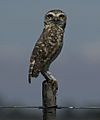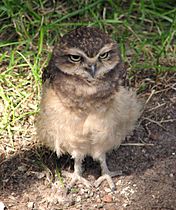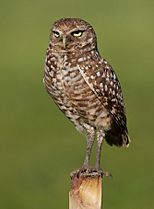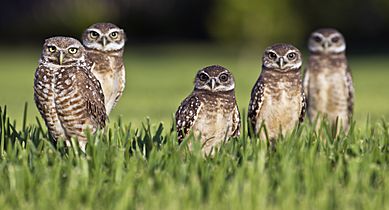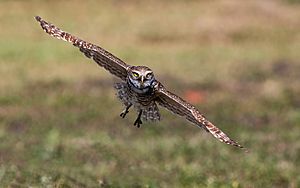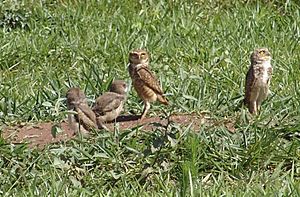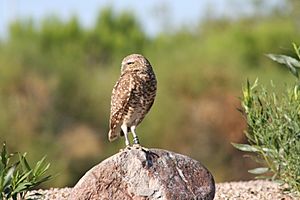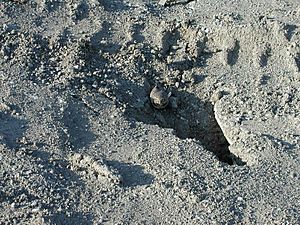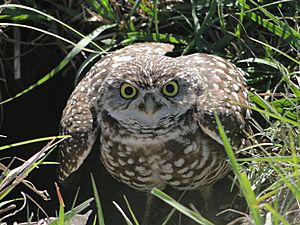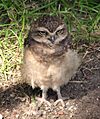Burrowing owl facts for kids
Quick facts for kids Burrowing owl |
|
|---|---|
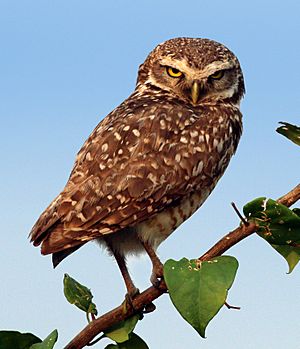 |
|
| Brazilian burrowing owl A. c. grallaria Pantanal, Brazil |
|
| Conservation status | |
| Scientific classification | |
| Genus: |
Athene
|
| Species: |
cunicularia
|
| Subspecies | |
|
About 20 living, see text |
|
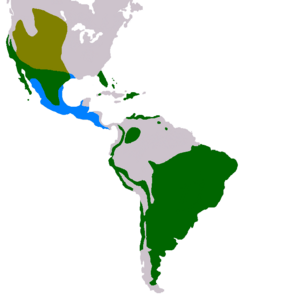 |
|
| Range of A. cunicularia Summer breeding range Winter non-breeding range Resident breeding range | |
| Synonyms | |
|
Strix cunicularia Molina, 1782 |
|
The burrowing owl (Athene cunicularia), also known as the shoco, is a small owl with long legs. You can find these owls in open areas across North and South America. They live in grasslands, deserts, and farm areas. They make their homes in burrows, which are underground tunnels. Often, they use burrows dug by animals like prairie dogs.
Unlike most owls, burrowing owls are often active during the day. However, they usually hunt at dawn and dusk. This is when their excellent night vision and hearing help them catch food. Because they live in open grasslands, these owls have longer legs. This helps them run fast or fly when they are hunting.
Contents
About the Burrowing Owl
Owl Family Tree
The burrowing owl was first officially described in 1782 by a Spanish scientist named Juan Ignacio Molina. Later, in 1822, a German zoologist named Friedrich Boie placed this owl in the Athene group.
Today, there are 18 known types, or subspecies, of burrowing owls. Sadly, two of these types are now extinct.
-
Brazilian burrowing owl (A. c. grallaria)
Jaú (São Paulo, Brazil)
What They Look Like
Burrowing owls have bright eyes and a beak that can be dark yellow or gray. They do not have ear tufts like some other owls. They have clear white eyebrows and a white patch under their chin. They can puff out this chin patch when they are upset or excited.
Adult owls have brown heads and wings with white spots. Their chests and bellies are white with brown spots or stripes. Young owls look similar but have fewer white spots and brown stripes. Young owls also have a light bar across their upper wings. Their chests might be buff-colored instead of white. All burrowing owls have grayish legs that are longer than other owls' legs.
Male and female owls look very similar in size and appearance. Females are usually a bit heavier. Males often have longer wings and tails. Adult males may look lighter in color than females. This is because they spend more time outside in the sun, which can bleach their feathers. A burrowing owl is about 19–28 cm (7–11 in) long. Its wingspan is about 50.8–61 cm (20–24 in). It weighs between 140–240 g (5–8 oz). This means an average adult owl is a little bigger than an American robin.
Where They Live
Before Europeans arrived, burrowing owls likely lived in all suitable open areas of the New World. In North America, their living areas have shrunk since then. But in parts of South America, they are actually spreading. This is happening because of deforestation, which creates more open land.
Burrowing owls live year-round in most of their range. However, owls that breed in Canada and the northern U.S. often migrate south. They fly to Mexico and the southern U.S. during the winter months.
How They Behave
These owls can live for at least 9 years in the wild. In zoos, they can live for over 10 years. They sometimes get hit by cars when crossing roads. They also have many natural enemies. These include badgers, coyotes, and snakes. Even feral and domestic cats and dogs can kill them.
Burrowing owls often use burrows made by ground squirrels. This is a strategy also used by rattlesnakes. If an owl feels threatened, it will go into its burrow. There, it makes rattling and hissing sounds. These sounds are very similar to those of a rattlesnake. This behavior is thought to be a way of tricking predators. It works well against animals that know the dangers of rattlesnakes.
Family Life
The nesting season in North America starts in late March or April. Burrowing owls usually have one mate. But sometimes, a male owl might have two mates. Owl pairs sometimes nest together in small groups. Their favorite breeding spots are open grasslands. However, they can also live in other open areas. These include airports, golf courses, and farm fields. Burrowing owls are somewhat used to humans. They often nest near roads, farms, and homes.
The owls nest in a burrow, which is how they got their name. If there are no burrows, and the ground is soft enough, they might dig their own. They will also nest in shallow, man-made underground places. These places must have easy access to the surface.
During nesting season, burrowing owls gather many things to line their nest. They also leave some materials around the burrow entrance. The most common material is animal dung, often from cattle. People once thought the dung helped hide the smell of the young owls. But now, scientists believe the dung helps control the temperature inside the burrow. It also attracts insects, which the owls can eat.
The female owl lays one egg every one or two days. She will lay a total of four to 12 eggs, but usually nine. She then sits on the eggs for 3–4 weeks. During this time, the male brings her food. After the eggs hatch, both parents feed the chicks. Four weeks after hatching, the chicks can fly short distances. They also start to leave the nest burrow. The parents continue to help feed the chicks for 1–3 months.
Owls sometimes reuse the same nest for several years. But owls from northern areas, who migrate, are less likely to return to the same burrow each year. Also, female owls are more likely to move to a different nesting site than male owls.
What They Eat
When hunting, burrowing owls wait on a high spot until they see prey. Then, they swoop down to catch it. They might also fly up to catch insects in the air. Sometimes, they even chase prey on the ground. Their diet is varied. It includes invertebrates (like insects) and small vertebrates (like small animals). About one-third of their diet is invertebrates, and two-thirds are small vertebrates.
Burrowing owls mainly eat large insects and small rodents. Even though they often live near ground squirrels, they rarely hunt them. They also hunt bats. Studies show they eat many insects, other birds, reptiles, amphibians, and a few mammals.
They really like termites and different kinds of grasshoppers and crickets. They also eat certain types of beetles and scorpions. Small ground beetles are a favorite. They also eat earthworms. Burrowing owls are known to put animal droppings around their burrows. This attracts dung beetles, which then become a steady food source for the owls. They can also eat insects attracted to outdoor lights at night.
Unlike other owls, burrowing owls also eat fruits and seeds. They especially like the fruit of certain cacti, like tasajillo and prickly pear. On Clarion Island, where there are no mammals to hunt, they mostly eat crickets and cactus fruit. They sometimes add young birds like Clarión wrens to their diet.
Protecting Burrowing Owls
The burrowing owl is an endangered species in Canada. It is a threatened species in Mexico. In some U.S. states like Colorado and Florida, it is also considered threatened. However, in many Neotropical countries, they are common. They even live in fields and parks in cities there. In areas near the Amazon Rainforest, their numbers are growing due to deforestation. Because of this, the owl is listed as Least Concern on the IUCN Red List. This means it is not currently at high risk of extinction globally.
Burrowing owls are protected by the Migratory Bird Treaty Act of 1918 in Canada, the United States, and Mexico. They are also listed in CITES Appendix II, which controls trade of certain species.
Why Burrows Are Important
The main reasons burrowing owl populations are decreasing in North America are habitat loss. Also, programs that control burrowing animals like prairie dogs cause problems. While some burrowing owls can dig their own burrows, most rely on other animals to dig holes for them. These holes provide shelter and nesting spots.
There is a strong link between where burrowing animals live and where burrowing owls are found. When prairie dog populations decline, burrowing owl numbers also tend to drop. For example, Western burrowing owls use burrows made by black-tailed prairie dogs. They cannot dig their own. However, prairie dog numbers have gone down. This is partly due to programs that try to get rid of prairie dogs. Prairie dogs can dig up plants, which causes problems for farmers.
When burrowing animal populations decrease, owls become more vulnerable to predators. With fewer burrows, more owls might crowd into the remaining ones. This makes it easier for predators to find and harm larger groups of owls. Prairie dogs and ground squirrels also act as a shield for owls. Predators might hunt them instead of the owls. Prairie dogs also make alarm calls that warn owls if predators are near. This gives the owls time to hide. Without burrowing animals, many things that help owls live safely will be gone.
Some groups have tried to help by digging artificial burrows for owls. This is done in areas where there are no active burrowing animal colonies. However, creating artificial burrows is not a long-term solution.
Humans and Owls
Burrowing owls can live in places changed by humans. These include airport grasslands or golf courses. They can also use artificial nests, like plastic burrows. Owls living in cities have shown they can dig their own burrows. They also react differently to humans and pets compared to owls in rural areas. Research suggests these owls are adapting to cities. So, conservation efforts should consider these changes. Genetic studies show that inbreeding is not a problem for North American burrowing owls.
Helping Owls Move
Sometimes, burrowing owls live in areas where new buildings are planned. In these cases, a special technique is used to move them. Instead of catching and moving the owls, which can be stressful, they are encouraged to move on their own. This process starts months before any building begins. Scientists watch the owl colony to learn their movements and favorite spots.
Then, a new location nearby is chosen. This new spot must have good ground and be a suitable breeding place for owls. The new site is improved by adding burrows and perches. Once the owls show interest in the new location, they are prevented from entering their old burrows. A simple one-way door is placed over the old burrow entrance. If everything is done correctly, the owls will move to the new site within a few nights. The new colony needs to be watched until the human construction nearby is finished.
Images for kids
See also
 In Spanish: Athene cunicularia para niños
In Spanish: Athene cunicularia para niños






